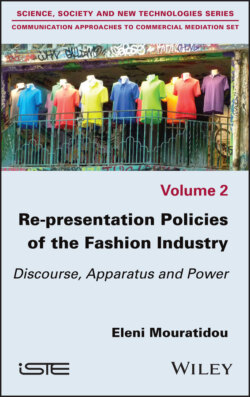Читать книгу Re-presentation Policies of the Fashion Industry - Eleni Mouratidou - Страница 14
I.6. The power of the fashion industry’s re-presentational apparatus
ОглавлениеThe fashion industry’s re-presentation policies will thus be approached as constituting an apparatus that grants the industry in question a “power of institution, authorization and legitimization as a result of the thoughtful functioning of the apparatus on itself” (Marin 1981, p. 10, author’s translation). It is throughout part 3 of this research that I will attempt to account for the mechanisms through which the fashion industry’s re-presentational apparatus presents a power aim. Following Michel Foucault and the way he defined the heterogeneous dimension of the apparatus, the objective of this research will be to analyze the fashion industry’s re-presentational policies, their material and formal formats29. Thus, the apparatus is thought of as “a heterogeneous whole, comprising discourses, institutions, architectural arrangements, regulatory decisions, laws, administrative measures, scientific statements, philosophical, moral, philanthropic proposals, in brief: of the said as well as of the unsaid” (Foucault 1994, p. 299, author’s translation), as well as “everything that has, in one way or another, the capacity to capture, orient, determine, intercept, shape, control and ensure the gestures, conduct, opinions and discourses of living beings” (Agamben 2014, p. 31, author’s translation).
The fashion industry’s re-presentational apparatus is therefore a plural continuum of media, discourses and practices understood as a single instance, despite their spatiotemporal discontinuity. Indeed, it draws its power and its symbolic and pragmatic effectiveness from the coupling it offers between the continuous and the discontinuous.
If practices and discourses manifest themselves in a scattered way in a strategically thought-out space-time, they are also iterative; this allows for the interaction between the event-driven and discontinuous dimension of re-presentational policies and a programmed and repetitive event. Moreover, in spite of the heterogeneity of the apparatus’s constituent elements, they manage to form, in fine, a homogeneous continuum because they are determined by the same underlying strategies and their aim is the same issues of modeling, interception or control: those of the presence of the fashion industry as a non-exclusively commercial instance and therefore its re-presentation and requalification.
